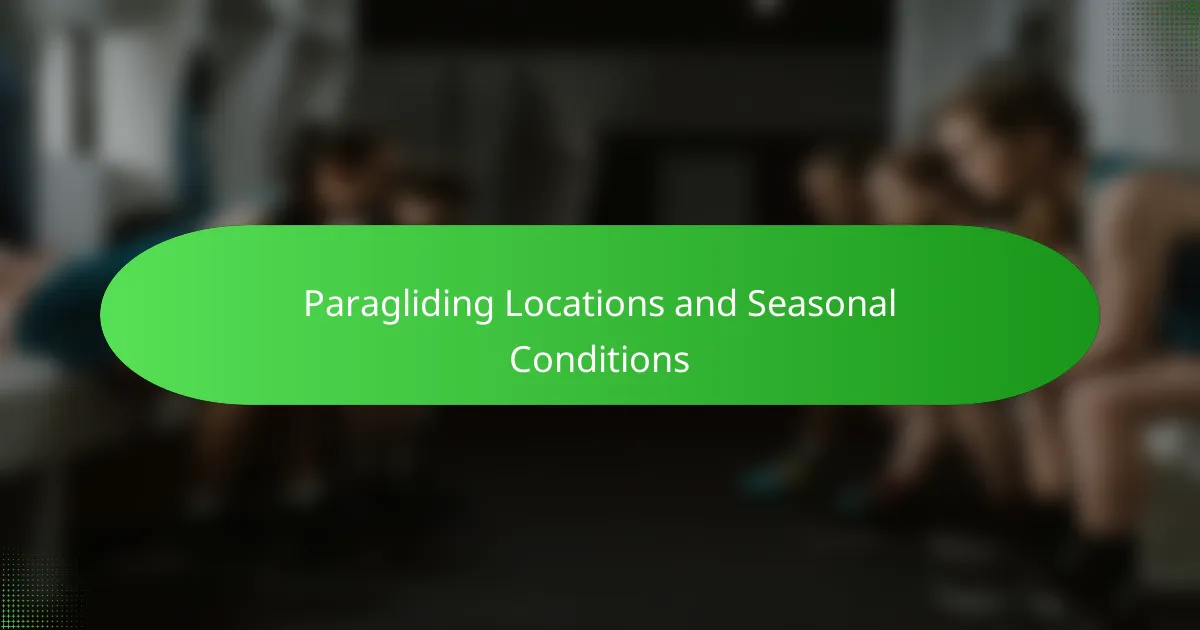Choosing the right paragliding location is crucial for an enjoyable and safe experience. Seasonal conditions impact weather patterns, wind speeds, and thermal activity. Popular spots like Interlaken and Oludeniz offer unique advantages throughout the year. Understanding these factors helps pilots make informed decisions and select appropriate gear.

Which Factors Influence Paragliding Locations?
Weather patterns, terrain features, and accessibility significantly influence paragliding locations. Weather conditions, such as wind speed and thermal activity, determine flying safety and performance. Locations with varied topography offer different flying experiences, from mountains to coastal areas. Accessibility ensures that pilots can reach takeoff points easily, impacting overall enjoyment and feasibility.
How Do Terrain and Geography Affect Paragliding Opportunities?
Terrain and geography significantly influence paragliding opportunities by determining wind patterns, elevation, and landscape features. Locations with varied topography, such as mountains or cliffs, provide optimal launch sites and thermal currents. Seasonal conditions like temperature and precipitation further affect safety and accessibility. For example, coastal areas often experience consistent winds, enhancing flying conditions. In contrast, flat terrains may limit flight duration and experience. Understanding these factors helps paragliders select ideal locations and times for their activities.
What Role Do Weather Patterns Play in Choosing Paragliding Sites?
Weather patterns significantly influence the selection of paragliding sites. Ideal conditions include consistent thermals, predictable wind patterns, and minimal precipitation.
Key weather factors for paragliding locations are:
| Weather Factor | Ideal Conditions | Impact on Paragliding |
|———————|—————————–|—————————–|
| Wind Speed | 10-20 km/h | Provides lift and control |
| Thermal Activity | Strong, consistent thermals | Enhances soaring potential |
| Precipitation | Low to moderate | Reduces risk of turbulence |
| Temperature | Mild, stable temperatures | Ensures comfort and performance|
| Seasonal Patterns | Predictable seasons | Helps in planning trips |
Understanding these patterns helps pilots choose the safest and most enjoyable locations for their paragliding adventures.
How Do Local Regulations Impact Paragliding Locations?
Local regulations significantly influence paragliding locations by determining safety standards, access permissions, and environmental protections. These rules can restrict or enhance flying opportunities based on local topography and weather conditions. For instance, certain areas may require permits or limit seasonal access to protect wildlife or local communities. Understanding these regulations is crucial for pilots to ensure compliance and maximize their flying experience. Additionally, unique attributes of specific locations, such as proximity to restricted airspace, can further impact the feasibility of paragliding in those areas.

What Are the Best Paragliding Locations Around the World?
The best paragliding locations worldwide include places with optimal seasonal conditions for flight. Notable locations are:
1. Interlaken, Switzerland | Summer | Stunning alpine scenery and reliable thermals.
2. Oludeniz, Turkey | Spring | Famous for its breathtaking views and consistent winds.
3. Valle de Bravo, Mexico | Winter | Ideal weather and beautiful lake views attract many pilots.
4. Queenstown, New Zealand | Autumn | Known for its diverse landscapes and favorable flying conditions.
5. Lake Bled, Slovenia | Summer | Offers picturesque scenery and stable weather patterns.
6. Chamonix, France | Summer | Renowned for its majestic mountains and excellent lift.
Which Regions Are Known for Their Ideal Paragliding Conditions?
Regions known for ideal paragliding conditions include the French Alps, the Swiss Alps, and the Andes in South America. These areas offer consistent thermals, favorable wind patterns, and stunning landscapes. The French Alps provide extensive launch sites with reliable weather from spring to autumn. The Swiss Alps offer breathtaking views and diverse flying routes, particularly in summer. In South America, the Andes feature high-altitude launches and optimal conditions, especially during the southern hemisphere’s summer months.
What Unique Features Set Specific Paragliding Destinations Apart?
Unique features that set specific paragliding destinations apart include distinct landscapes, varying weather conditions, and local regulations. For example, the Andes offer high-altitude flying, while coastal regions provide thermal winds. Seasonal conditions like wind patterns and temperature fluctuations can enhance or limit the experience. Additionally, some locations feature unique cultural elements that enrich the adventure, such as local festivals or specialized equipment availability.

How Do Seasonal Conditions Affect Paragliding Experiences?
Seasonal conditions significantly impact paragliding experiences by influencing weather patterns, wind speeds, and thermal activity. Spring and summer typically offer favorable conditions with warmer temperatures and consistent thermals, enhancing lift. In contrast, winter may present challenges due to colder air and unpredictable weather. Rainy seasons can reduce visibility and safety, while autumn often provides stable conditions and beautiful landscapes. Understanding these seasonal variations helps pilots choose optimal times for flying.
What Are the Seasonal Variations in Weather for Popular Paragliding Locations?
Seasonal variations in weather significantly affect popular paragliding locations. For optimal conditions, spring and summer generally provide stable thermals and favorable winds, while autumn may offer unpredictable weather patterns. Winter often presents challenges due to strong winds and lower temperatures.
| Location | Spring Conditions | Summer Conditions | Autumn Conditions | Winter Conditions |
|——————-|—————————|—————————|—————————|—————————|
| Interlaken, Switzerland | Mild temperatures, good thermals | Warm weather, consistent winds | Variable weather, potential rain | Cold temperatures, strong winds |
| Oludeniz, Turkey | Pleasant temperatures, light winds | Hot weather, ideal for soaring | Cooling temperatures, stable conditions | Cooler, less flying days |
| Queenstown, New Zealand | Mild, increasing thermals | Warm, reliable conditions | Cooler, variable conditions | Cold, limited flying opportunities |
| Chamonix, France | Mild, increasing thermals | Warm, good flying conditions | Cooler, changing weather | Cold, frequent storms |
| Valle de Bravo, Mexico | Mild to warm, stable winds | Hot, excellent conditions | Cooling, variable conditions | Cooler, less reliable |
How Can Paragliders Prepare for Seasonal Challenges?
Paragliders can prepare for seasonal challenges by adjusting their gear and techniques based on weather conditions. Understanding local climate patterns, such as wind direction and thermal activity, is crucial.
1. Research seasonal weather patterns for your location.
2. Adjust equipment for temperature and humidity changes.
3. Practice specific techniques suited to seasonal winds.
4. Stay informed about local regulations and seasonal restrictions.
5. Join local paragliding groups for shared insights and experiences.
These steps enhance safety and performance throughout varying conditions, ensuring a successful paragliding experience.

What Are the Safety Considerations for Paragliding in Different Locations?
Paragliding safety varies significantly based on location and seasonal conditions. Factors such as terrain, weather patterns, and local regulations influence safety measures.
In mountainous regions, strong winds and sudden weather changes pose risks. It’s essential to check local forecasts and understand the terrain’s unique attributes. Coastal areas may have different wind patterns, requiring pilots to adapt their techniques.
Seasonal conditions also play a crucial role. For instance, flying during peak summer months may lead to thermals that can enhance lift but also increase turbulence. Conversely, winter conditions can lead to icy surfaces and reduced visibility.
Understanding these factors helps paragliders make informed decisions, ensuring a safer flying experience. Always prioritize local safety guidelines and consult experienced pilots familiar with the area.
How Do Environmental Factors Influence Safety in Paragliding?
Environmental factors significantly influence safety in paragliding by affecting conditions like wind patterns, visibility, and terrain. Locations with stable weather and clear airspace enhance safety. Seasonal conditions, such as thermal activity in summer, can increase risk, while winter may limit flying opportunities.
Key factors include altitude, which affects wind strength, and proximity to obstacles like mountains or buildings. For example, coastal areas may experience strong sea breezes, impacting flight stability. Awareness of local weather patterns and seasonal changes is crucial for safe paragliding.
What Precautions Should Be Taken Based on Seasonal Conditions?
Paragliding requires specific precautions based on seasonal conditions to ensure safety. In winter, check for snow and ice on launch sites. In summer, monitor thermal activity and wind patterns. During rainy seasons, avoid areas prone to storms. Always assess visibility and weather forecasts before flying.

How to Choose the Right Paragliding Gear for Different Locations?
Selecting the right paragliding gear for various locations depends on environmental conditions and personal preferences. Consider altitude, wind patterns, and seasonal weather when choosing equipment.
1. **Altitude**: Higher altitudes require specialized gear like lightweight wings for better performance.
2. **Wind Patterns**: Locations with strong winds necessitate durable, high-performance canopies.
3. **Seasonal Weather**: Cold climates demand insulated clothing and gear, while warm areas benefit from breathable fabrics.
4. **Location-Specific Regulations**: Familiarize yourself with local laws regarding equipment.
5. **Personal Experience Level**: Beginners should opt for user-friendly gear, while experienced pilots may prefer advanced models.
By assessing these factors, you can ensure your paragliding gear is well-suited to your chosen location.
Which Gear Is Best Suited for Varied Weather Conditions?
For varied weather conditions in paragliding, gear with adjustable features is essential. Look for equipment that can adapt to changing temperatures, wind speeds, and precipitation.
1. **Wing Type**: Choose versatile wings designed for different weather conditions. For example, all-rounder wings perform well in both light and strong winds.
2. **Harness**: Opt for a harness with insulation options to provide warmth during colder flights. Some models include removable padding.
3. **Clothing**: Layered clothing is crucial. Use moisture-wicking base layers, insulating mid-layers, and waterproof outer layers to stay comfortable.
4. **Safety Gear**: Invest in a reliable helmet and reserve parachute suitable for various weather scenarios to ensure safety regardless of conditions.
Selecting the right gear enhances safety and performance across diverse paragliding locations and seasonal conditions.
What Are the Essential Attributes of Paragliding Equipment for Specific Locations?
Essential attributes of paragliding equipment vary by location and seasonal conditions. Key factors include wing size, material durability, and harness design.
1. Wing Size: Adjust based on altitude and wind conditions. Larger wings suit low-altitude, calm environments, while smaller wings are better for high-altitude, turbulent areas.
2. Material Durability: Equipment must withstand local weather patterns. Coastal regions require water-resistant materials, while mountainous areas benefit from robust, abrasion-resistant fabrics.
3. Harness Design: Comfort and safety are paramount. Harnesses should offer adequate support for long flights in varying temperatures, with features like ventilation for warmer climates.
4. Additional Gear: Include location-specific items like reserve parachutes for mountainous areas and GPS devices for navigation in remote regions.
Understanding these attributes enhances safety and performance in diverse paragliding environments.

What Are the Common Mistakes to Avoid When Paragliding in New Locations?
To avoid common mistakes when paragliding in new locations, prioritize thorough preparation and awareness of local conditions. Key mistakes include neglecting to research weather patterns, failing to check for restricted airspaces, and overlooking local regulations. Additionally, not familiarizing yourself with the landing zones can lead to dangerous situations. Always connect with local pilots for insights on specific challenges in the area.
How Can Paragliders Ensure They Are Prepared for Local Conditions?
Paragliders can prepare for local conditions by researching weather patterns, understanding terrain features, and checking forecasts. Familiarity with local flying regulations and seasonal variations is crucial. For example, high winds in spring can differ significantly from calm summer evenings. Engaging with local flying communities can provide valuable insights into specific conditions and tips for safe flying.
What Expert Tips Can Enhance the Paragliding Experience Across Different Regions?
To enhance the paragliding experience across different regions, consider local weather patterns, terrain characteristics, and seasonal conditions. Understanding these factors ensures safety and maximizes enjoyment.
1. Research local weather forecasts to identify optimal flying conditions.
2. Select locations with diverse terrains for varied experiences.
3. Plan trips according to seasonal wind patterns for better control.
4. Connect with local paragliding communities for insights on unique regional attributes.
